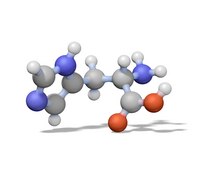540411 Sigma-AldrichPuromycin, Dihydrochloride, Cell Culture-Tested - CAS 58-58-2 - Calbiochem
Puromycin, CAS 58-58-2, is a protein synthesis inhibitor that causes premature release of nascent polypeptide chains.
More>> Puromycin, CAS 58-58-2, is a protein synthesis inhibitor that causes premature release of nascent polypeptide chains. Less<<Productos recomendados
Descripción
| Replacement Information |
|---|
Tabla espec. clave
| CAS # | Empirical Formula |
|---|---|
| 58-58-2 | C₂₂H₂₉N₇O₅ · 2HCl |
| Product Information | |
|---|---|
| CAS number | 58-58-2 |
| Form | White to off-white solid |
| Hill Formula | C₂₂H₂₉N₇O₅ · 2HCl |
| Chemical formula | C₂₂H₂₉N₇O₅ · 2HCl |
| Quality Segment | MQ100 |
| Applications |
|---|
| Biological Information | |
|---|---|
| Primary Target | protein synthesis |
| Purity | ≥98% by HPLC |
| Physicochemical Information | |
|---|---|
| Contaminants | Endotoxin: ≤10 EU/mg dry weight |
| Dimensions |
|---|
| Materials Information |
|---|
| Toxicological Information |
|---|
| Safety Information according to GHS | |
|---|---|
| RTECS | AU7355000 |
| Safety Information |
|---|
| Product Usage Statements |
|---|
| Packaging Information |
|---|
| Transport Information |
|---|
| Supplemental Information |
|---|
| Specifications |
|---|
| Global Trade ITEM Number | |
|---|---|
| Número de referencia | GTIN |
| 540411 | 0 |
Documentation
Puromycin, Dihydrochloride, Cell Culture-Tested - CAS 58-58-2 - Calbiochem Ficha datos de seguridad (MSDS)
| Título |
|---|
Puromycin, Dihydrochloride, Cell Culture-Tested - CAS 58-58-2 - Calbiochem Certificados de análisis
| Cargo | Número de lote |
|---|---|
| 540411 |
Referencias bibliográficas
| Visión general referencias |
|---|
| Chow, S.C., et al. 1995. Exp. Cell Res. 216, 149. Kaufman, S.H., et al. 1993. Cancer Res. 53, 3976. de la Luna, S. and Ortín, J. 1992. Methods Enzymol. 216, 376. Chow, S.C., et al. 1991. Exp. Cell Res. 216, 149. |
Folleto
| Cargo |
|---|
| Antibiotics Profiler |
| The Complete Molecular Biology Toolkit - Expert workflow solutions from DNA cloning to protein expression |












